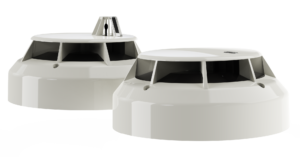The landscape of fire safety is constantly evolving, demanding innovation and adaptation from manufacturers like Hochiki Europe, a global leader in life safety solutions.
Their recent introduction of a novel generation of UL-listed smoke detectors signifies a significant step forward, ensuring compliance with the stringent requirements of the UL268 7th Edition standard.
Read on as we delve into the implications of this new standard, the features of Hochiki’s groundbreaking detectors, and their impact on conventional fire detection systems.
Navigating the Evolving Landscape of Fire Safety Standards
The UL268 7th Edition standard, initially scheduled for implementation in 2021, dictates fire detector performance for manufacturers. This revised standard enforces stricter guidelines, particularly regarding multi-spectrum smoke categorisation. This new requirement necessitates detectors adept at identifying smouldering and flaming fires fuelled by specific materials like polyurethane furniture foam, while simultaneously minimising nuisance false alarms. This crucial change demands the development of entirely new detector ranges from manufacturers to guarantee adherence to the updated standard.
Conventional Fire Detection: Safeguarding a Diverse Range of Applications
Conventional fire detection systems find their niche in safeguarding various structures, including small retail units, workshops, storage facilities, medical clinics, and educational institutions. Renowned for their reliability in minimising false alarms, Hochiki’s conventional fire detection products have consistently delivered exceptional performance. Their latest range of 7th edition detectors builds upon this legacy, incorporating cutting-edge technology to fulfil the demands of the revised UL268 standard.
Introducing Hochiki Europe’s 7th Edition Conventional Smoke and Multi-Sensor Detectors – A Comprehensive Look at the Key Features
1. Enhanced Detection Capabilities:
A redesigned smoke chamber optimises airflow and smoke intake, ensuring accurate detection.
Multi-spectrum smoke categorisation technology empowers the detectors to effectively respond to diverse fire types, including those fuelled by traditional materials and polyurethane, adhering to the stringent requirements of the UL268 7th Edition.
2. Precision Through Innovation:
Dual LED technology utilises red and blue internal emitters positioned at varying angles. This revolutionary approach enables the detectors to differentiate between smoke particle types more effectively, leading to precise fire detection.
3. Intelligent Algorithms for Minimised False Alarms:
Equipped with cutting-edge algorithms, these detectors can intelligently distinguish between genuine fires and common triggers of false alarms like steam and cooking, ensuring efficient and reliable detection across various environments.
4. Proactive Maintenance and User-Friendly Status Indication:
Automatic drift compensation built-in software continuously monitors the detectors’ optical elements, compensating for gradual dirt accumulation and maintaining accurate sensitivity and response through automatic adjustments.
Bi-coloured status indication via a green/red LED offers a clear visual indication of the detector’s status. A flashing green LED signifies normal operation, while a red flash indicates sensitivity drifting beyond the UL-listed threshold, prompting maintenance. A constant red LED denotes an active alarm.
Hochiki Europe: Leading the Way in Fire Safety Solutions
By introducing this range of detectors, Hochiki Europe reaffirms its position as a frontrunner in the fire safety domain. These innovative products not only cater to the demands of the UL268 7th Edition but also represent an unwavering commitment to exceeding industry standards and prioritising unparalleled safety solutions. As fire safety regulations continue to evolve, Hochiki Europe stands firm in its dedication to developing cutting-edge technologies that safeguard lives and property.
For more information about Hochiki Europe’s latest products and innovations, please visit the website.


